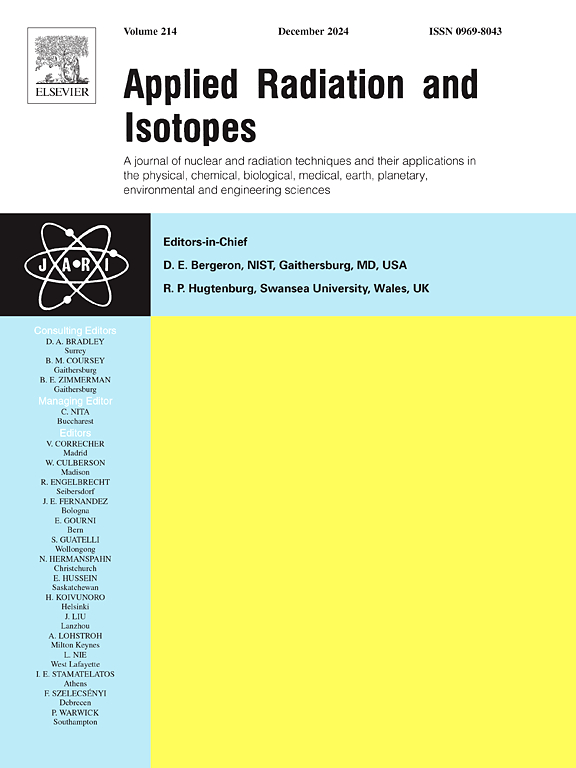彩色颜料对商品水泥在伽马辐射下热释光响应的影响
IF 1.8
3区 工程技术
Q3 CHEMISTRY, INORGANIC & NUCLEAR
引用次数: 0
摘要
本研究通过研究五种市售的颜料水泥(绿色、黄色、蓝色、黑色和栗色)对γ辐射(0-10 Gy)的热释光(TL)响应,探索了它们作为低成本回顾性剂量计的潜力。值得注意的是,与栗色、黑色和绿色水泥相比,蓝色和黄色水泥表现出明显更高的TL强度(38 - 82%)。在8 Gy以下观察到线性剂量响应(R2 >;0.98),其中蓝色水泥的灵敏度最高(256.04 nC/Gy)。线性指数(f(D))值表明,在低至中等剂量时接近线性,在较高剂量时观察到超线性。TL衰减遵循指数衰减,蓝色水泥在30天后保留了约76%的信号。利用峰形法确定动力学参数,包括活化能(E)、频率因子(s)和寿命(τ),揭示了不同水泥中圈闭深度和重组机制的变化。蓝色水泥的EDX分析确定了影响TL捕获机制的关键元素成分(Ca, Si, Al, Fe)和微量金属。这些发现有力地表明,颜料水泥追溯剂量测定的可行性,保证进一步研究陷阱动力学和光谱发射。本文章由计算机程序翻译,如有差异,请以英文原文为准。
Effect of colour pigments on the thermoluminescence response of commercial cement under gamma radiation
This study explores the potential of five commercially available pigmented cements (green, yellow, blue, black, and maroon) as low-cost retrospective dosimeters by investigating their thermoluminescent (TL) response to gamma radiation (0–10 Gy). Notably, blue and yellow cements exhibited significantly higher TL intensities (38–82 %) compared to maroon, black, and green. A linear dose-response was observed up to 8 Gy (R2 > 0.98), with blue cement demonstrating the highest sensitivity (256.04 nC/Gy). Linearity index (f(D)) values indicated near-linear behavior for low to moderate doses, with supralinearity observed at higher exposures. TL fading followed an exponential decay, with blue cement retaining ∼76 % of its signal after 30 days. Kinetic parameters, including activation energy (E), frequency factor (s), and lifetime (τ), were determined using the peak shape method, revealing variations in trap depths and recombination mechanisms across the different cements. EDX analysis of blue cement identified key elemental constituents (Ca, Si, Al, Fe) and trace metals that influence TL trapping mechanisms. These findings strongly suggest the viability of pigmented cements for retrospective dosimetry, warranting further research into trap kinetics and spectral emissions.
求助全文
通过发布文献求助,成功后即可免费获取论文全文。
去求助
来源期刊

Applied Radiation and Isotopes
工程技术-核科学技术
CiteScore
3.00
自引率
12.50%
发文量
406
审稿时长
13.5 months
期刊介绍:
Applied Radiation and Isotopes provides a high quality medium for the publication of substantial, original and scientific and technological papers on the development and peaceful application of nuclear, radiation and radionuclide techniques in chemistry, physics, biochemistry, biology, medicine, security, engineering and in the earth, planetary and environmental sciences, all including dosimetry. Nuclear techniques are defined in the broadest sense and both experimental and theoretical papers are welcome. They include the development and use of α- and β-particles, X-rays and γ-rays, neutrons and other nuclear particles and radiations from all sources, including radionuclides, synchrotron sources, cyclotrons and reactors and from the natural environment.
The journal aims to publish papers with significance to an international audience, containing substantial novelty and scientific impact. The Editors reserve the rights to reject, with or without external review, papers that do not meet these criteria.
Papers dealing with radiation processing, i.e., where radiation is used to bring about a biological, chemical or physical change in a material, should be directed to our sister journal Radiation Physics and Chemistry.
 求助内容:
求助内容: 应助结果提醒方式:
应助结果提醒方式:


